What's New Under The Sun
Preparing for the Solar Eclipse of April 8th 2024
Sunday, 24 March 2024 18:30
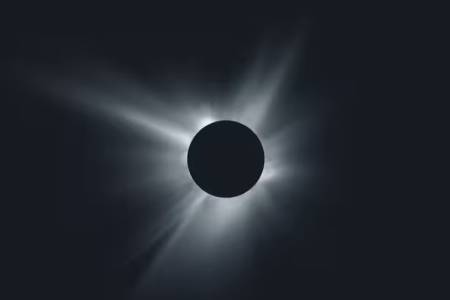 There are lots of maps showing where to go for the April 8th 2024 total solar eclipse and others showing the statistical chance of clouds such as https://www.washingtonpost.com/weather/2024/02/22/april-eclipse-clouds/ From Little Rock Arkansas to the Mazatlan coast there is a high probability of clear weather. The cities from Indianapolis through Cleveland OH, Rochester and Syracuse...
There are lots of maps showing where to go for the April 8th 2024 total solar eclipse and others showing the statistical chance of clouds such as https://www.washingtonpost.com/weather/2024/02/22/april-eclipse-clouds/ From Little Rock Arkansas to the Mazatlan coast there is a high probability of clear weather. The cities from Indianapolis through Cleveland OH, Rochester and Syracuse...
Seiko Designs Equatorial Sundial Watch
Sunday, 24 March 2024 01:42
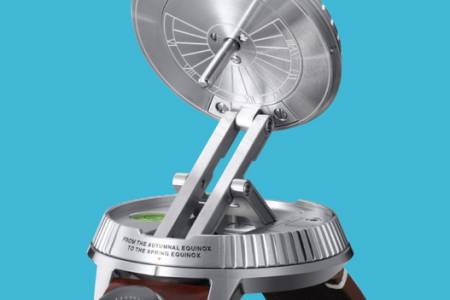 When is a watch not a watch? When it unfolds into an equatorial sundial. The watch, designed by Yu Ishihara is called a "Watch Exclusively for Sunny Men" and was part of a contest sponsored by Seiko to "help reimagine what a watch can be", aimed at creativity and perhaps for eventual production. Read about it at...
When is a watch not a watch? When it unfolds into an equatorial sundial. The watch, designed by Yu Ishihara is called a "Watch Exclusively for Sunny Men" and was part of a contest sponsored by Seiko to "help reimagine what a watch can be", aimed at creativity and perhaps for eventual production. Read about it at...
Rare Astrolabe Discovered by Chance in Verona Museum
Wednesday, 06 March 2024 00:17
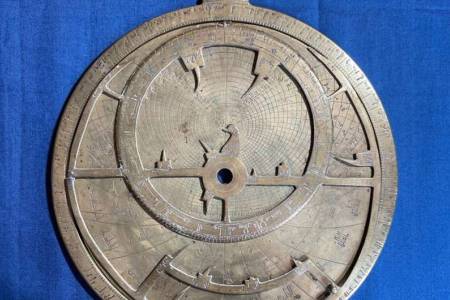 Dr. Federica Gigante, from Cambridge Univerity's History Faculty, discovered a rare astrolabe sequestered in a museum at Verona, Italy. Publishing in Nuncius (1 March 2024) Dr. Gigante presents "a hitherto unknown remarkable astrolabe from Al-Andalus which likely belonged to the collection of Ludovico Moscardo (1611–1681) assembled in Verona in the seventeenth century. The...
Dr. Federica Gigante, from Cambridge Univerity's History Faculty, discovered a rare astrolabe sequestered in a museum at Verona, Italy. Publishing in Nuncius (1 March 2024) Dr. Gigante presents "a hitherto unknown remarkable astrolabe from Al-Andalus which likely belonged to the collection of Ludovico Moscardo (1611–1681) assembled in Verona in the seventeenth century. The...
NASS 2024 Conference to be held in Vancouver, BC June 20-23
Friday, 23 February 2024 17:42
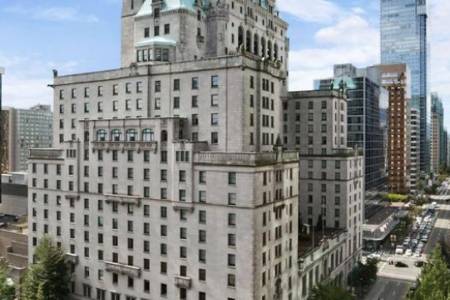 The North American Sundial Society (NASS) will hold its 2024 conference in Vancouver, British Columbia, Canada from Thrursday June 20th to Sunday June 23rd. The conference will be held at the Fairmont Hotel Vancouver, 900 West Georgia Street, Vancouver BC. The conference will start Thursday afternoon with a traditional reception and sundial door prizes. Friday will be a...
The North American Sundial Society (NASS) will hold its 2024 conference in Vancouver, British Columbia, Canada from Thrursday June 20th to Sunday June 23rd. The conference will be held at the Fairmont Hotel Vancouver, 900 West Georgia Street, Vancouver BC. The conference will start Thursday afternoon with a traditional reception and sundial door prizes. Friday will be a...
World Sundial Day
Friday, 23 February 2024 16:53
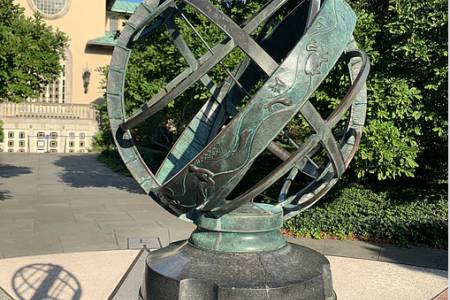 Spanish sundialist Esteban Martínez has launched the resolution to establish the World Sundial Day to occur each year on the Spring Equinox. According to the petition circulated by Martinez,
"Reason Sundials represent the union of disciplines as disparate as Astronomy, Mathematics, [and] Geography...They have an undoubted didactic value in teaching astronomy to young people and as...
Spanish sundialist Esteban Martínez has launched the resolution to establish the World Sundial Day to occur each year on the Spring Equinox. According to the petition circulated by Martinez,
"Reason Sundials represent the union of disciplines as disparate as Astronomy, Mathematics, [and] Geography...They have an undoubted didactic value in teaching astronomy to young people and as...
NASS Course "Elements of Dialing" Starts Jan 6, 2024
Saturday, 18 November 2023 18:21
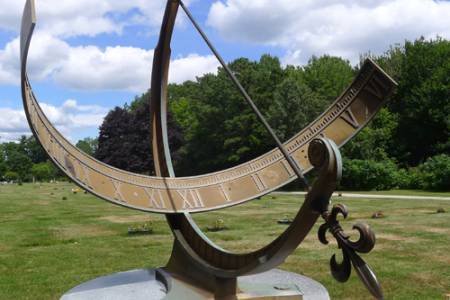 NASS is pleased to announce the upcoming third instance of Elements of Dialing, our introductory course about sundials, their history, and the science that makes them work. The free 13-lesson course, intended for those are new to sundialing, runs from January 2024. The course coordinator will be Steve Lelievre, our Secretary and editor of The Compendium. Steve will be assisted from time to time...
NASS is pleased to announce the upcoming third instance of Elements of Dialing, our introductory course about sundials, their history, and the science that makes them work. The free 13-lesson course, intended for those are new to sundialing, runs from January 2024. The course coordinator will be Steve Lelievre, our Secretary and editor of The Compendium. Steve will be assisted from time to time...
Smithsonian Photo Contest - Jaipur Sundial
Sunday, 05 November 2023 16:30
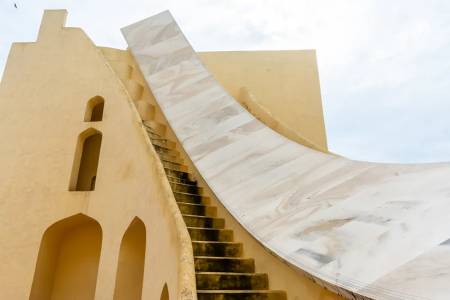 Smithsonian Magazine holds a photo-of-the-day contest. Winner on 30 Oct 2023 was Harita Sistu who took a photo of the large sundial of Jantar Mantar, Jaipur India (taken in July 2022). Harita notes: "I wanted to try my best to capture just how massive the instrument is and bring focus into the incredible skill that went into designing and constructing it."
See other NASS...
Smithsonian Magazine holds a photo-of-the-day contest. Winner on 30 Oct 2023 was Harita Sistu who took a photo of the large sundial of Jantar Mantar, Jaipur India (taken in July 2022). Harita notes: "I wanted to try my best to capture just how massive the instrument is and bring focus into the incredible skill that went into designing and constructing it."
See other NASS...
Houston Pavillion - World's Largest Sundial
Friday, 14 July 2023 23:08
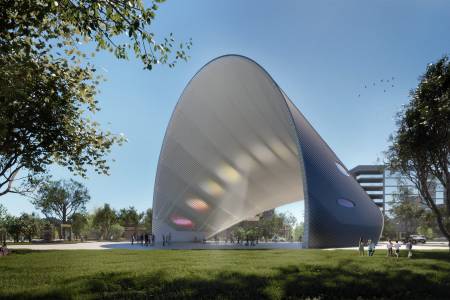 A sundial or performance center or solar generator? It's all three. Called the Arco del Tiempo (Arch of Time), the design by Berlin architect Riccardo Mariano provides the projection of the sun's rays onto the ground through tinted glass apertures spanning the length of its arching ceiling. The elliptical shaped spots change every hour, telling "the solar time each day and delight visitors with...
A sundial or performance center or solar generator? It's all three. Called the Arco del Tiempo (Arch of Time), the design by Berlin architect Riccardo Mariano provides the projection of the sun's rays onto the ground through tinted glass apertures spanning the length of its arching ceiling. The elliptical shaped spots change every hour, telling "the solar time each day and delight visitors with...
Sun Tower Update
Saturday, 01 July 2023 00:36
 According to NewAtlas.com (https://newatlas.com/architecture/sun-tower-open/), construction of the Sun Tower exhibition building and outdoor theater is underway in the Chinese city of Yantai. The tower is being constructed by a French firm, Ducks Sceno and the engineering firm Arup, raising to 50m (164 ft) gracefully into the sky. The tower symbolizes the historic watch towers of...
According to NewAtlas.com (https://newatlas.com/architecture/sun-tower-open/), construction of the Sun Tower exhibition building and outdoor theater is underway in the Chinese city of Yantai. The tower is being constructed by a French firm, Ducks Sceno and the engineering firm Arup, raising to 50m (164 ft) gracefully into the sky. The tower symbolizes the historic watch towers of...
Point of Infinity Hyperbolic Monument in San Francisco
Sunday, 25 June 2023 22:17
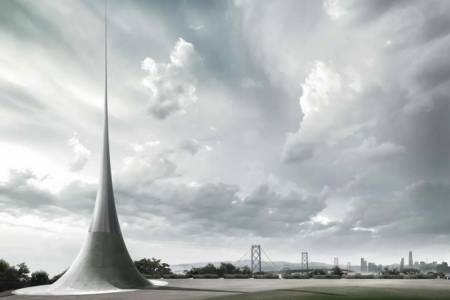 Julie Baumgardner in The Art Newspaper of Jan 13, 2023 reports on the construction project of Point of Infinity, a nearly 70 foot (21m) hyperbolic cone will reach toward the sky as part of a 50 million dollar park development on Treasure Island and Yerba Buena Island.
In a competition held by the San Francisco Arts Commision on behalf of the Treasure Island Development Authority, Hiroshi...
Julie Baumgardner in The Art Newspaper of Jan 13, 2023 reports on the construction project of Point of Infinity, a nearly 70 foot (21m) hyperbolic cone will reach toward the sky as part of a 50 million dollar park development on Treasure Island and Yerba Buena Island.
In a competition held by the San Francisco Arts Commision on behalf of the Treasure Island Development Authority, Hiroshi...
Ice Sculpture Ephemeral in Time
Thursday, 30 March 2023 00:03
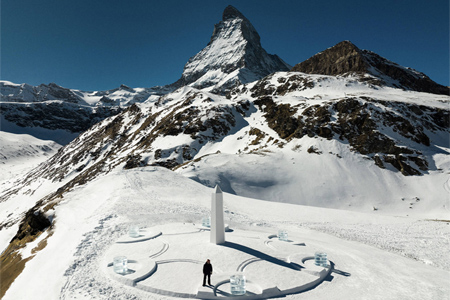 In the Swiss mountains near the resort of Zermatt just beneath the Matternhorn, Stir World reports that "famed luxury Swiss watchmaker Hublot announced Daniel Arsham as its new ambassador, with a compelling piece of temporary land art. Aptly titled "Light & Time", the work is a Hublot-inspired 20-metre sundial resting in the shadows of the Matterhorn mountain."
This sculptural is billed as...
In the Swiss mountains near the resort of Zermatt just beneath the Matternhorn, Stir World reports that "famed luxury Swiss watchmaker Hublot announced Daniel Arsham as its new ambassador, with a compelling piece of temporary land art. Aptly titled "Light & Time", the work is a Hublot-inspired 20-metre sundial resting in the shadows of the Matterhorn mountain."
This sculptural is billed as...
New Sundial for Kika Silva Pla Planetarium
Sunday, 18 December 2022 23:00
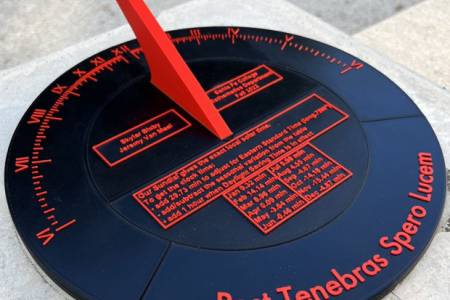 Sklar Bixby and Jeremy Meel, students at Santa Fe College in Florida took on a project to design and 3D-print a new sundial for the Kika Silva Pla Planetarium in Gainesville Florida (located on Santa Fe's Northwest Campus). Under the guidance of Dr. Philip Pinon, Sklar and Jeremy took on a semester long project as part of the Exploring Honors Mathematics class. They designed a horizontal sundial...
Sklar Bixby and Jeremy Meel, students at Santa Fe College in Florida took on a project to design and 3D-print a new sundial for the Kika Silva Pla Planetarium in Gainesville Florida (located on Santa Fe's Northwest Campus). Under the guidance of Dr. Philip Pinon, Sklar and Jeremy took on a semester long project as part of the Exploring Honors Mathematics class. They designed a horizontal sundial...
Interview with Sasch Stephens
- Details
- Hits: 2811
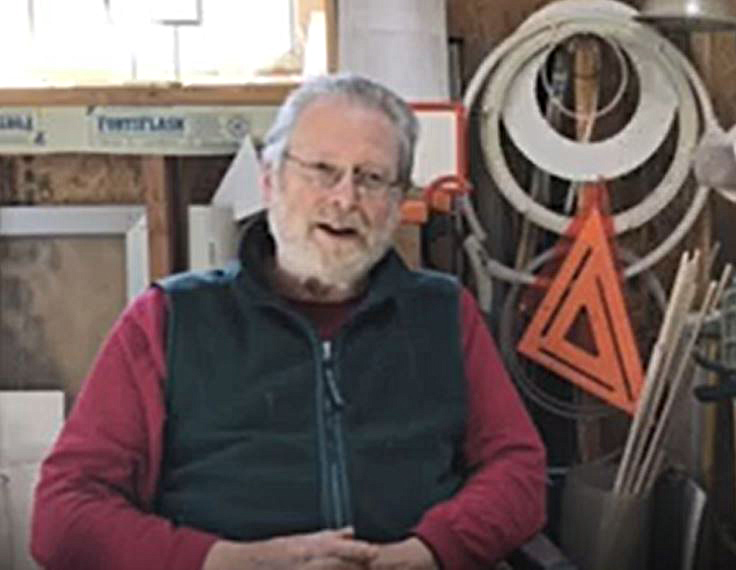 What makes a sundial? Practically anything. Sasch Stephens discusses how he became interested in dialing. Since then he has turned many objects into solar time devices. It takes some creative thinking to invision how a common object can become a working sundial. One of the most recent projects turned a 54 x 28 foot south side of a building it into a giant sundial mural in association with Allied Arts and the talents of artist Gretchen Leggitt. The dial was dedicated on September 22, 2018. View his interview at https://sundials.org/index.php/videos/making-and-using-sundials
What makes a sundial? Practically anything. Sasch Stephens discusses how he became interested in dialing. Since then he has turned many objects into solar time devices. It takes some creative thinking to invision how a common object can become a working sundial. One of the most recent projects turned a 54 x 28 foot south side of a building it into a giant sundial mural in association with Allied Arts and the talents of artist Gretchen Leggitt. The dial was dedicated on September 22, 2018. View his interview at https://sundials.org/index.php/videos/making-and-using-sundials
British Sundial Society Founder Christopher Daniel Passes
- Details
- Hits: 3158
 NASS is saddened to report the passing of one of the UK’s pre-eminent sundial designer, Christopher St. J H Daniel who died on May 17, 2022. His works are to be found all over the UK, ranging from private commissions to major public works and to restorations and reconstruction of old and damaged sundials.
NASS is saddened to report the passing of one of the UK’s pre-eminent sundial designer, Christopher St. J H Daniel who died on May 17, 2022. His works are to be found all over the UK, ranging from private commissions to major public works and to restorations and reconstruction of old and damaged sundials.
After a 13-year career at sea, Christopher Daniel joined the staff of the National Maritime Museum at Greenwich in 1964, working in the Department of Navigation & Astronomy. From 1967 onwards, his early curatorial responsibilities encouraged him to make a particular study of sundials and dialing literature. Christopher designed the now well- known "dolphin" equinoctial mean-time sundial at Greenwich, celebrating the Queen’s Silver Jubilee in 1977. In 1989 he and three others founded the British Sundial Society. From 1990, Christopher served as its Chairman, and more recently as President. His expertise and artistry in sundial design will be missed.
Netherland Sundial Society Founder Passes
- Details
- Hits: 2740
 Frans Maes of the Netherland Sundial Society writes: "We deeply regret to inform you that Hans de Rijk, founding member in 1978 and honorary member of the Netherlands' Sundial Society, passed away on November 23, at the age of 95. He served in the Board of the Society for many years and wrote some 150 articles in its Bulletin. Among these were important contributions, such as a latitude independent sundial, and the family of equator projection dials. A more playful result of his creativity were 'postcard dials', which he used to design while waiting for his Chinese take-away dinner."
Frans Maes of the Netherland Sundial Society writes: "We deeply regret to inform you that Hans de Rijk, founding member in 1978 and honorary member of the Netherlands' Sundial Society, passed away on November 23, at the age of 95. He served in the Board of the Society for many years and wrote some 150 articles in its Bulletin. Among these were important contributions, such as a latitude independent sundial, and the family of equator projection dials. A more playful result of his creativity were 'postcard dials', which he used to design while waiting for his Chinese take-away dinner."
"Hans was a popularizer of mathematics and astronomy and wrote many books about these subjects, under the pseudonym Bruno Ernst. His motto was: "Nescius omnium curiosus sum", I don't know anything but I am anxious to know everything. His eagerness to learn was equalled by his striving and ability to teach. He has been a teacher of mathematics and physics, founded the mathematics magazine 'Pythagoras' and the physics magazine 'Archimedes', aimed at secondary school students. He founded the first public astronomical observatory in the Netherlands. He also founded the organization 'Ars et mathesis', where art and mathematics meet, and its magazine with the same name. He became friends with the famous Dutch artist Maurits Cornelis Escher and wrote several books about Escher's work. Later on, he wrote extensively about impossible figures."
"Planetoid 11245 bears his name.".
"We lose a generous, inspiring, modest and productive diallist and friend."
The Netherland Sundial Society web pages is available in English at: https://www.dezonnewijzerkring.nl/pages/en/welcome.php?lang=EN
Sundial Garden Sprouts in Vancouver
- Details
- Hits: 8112
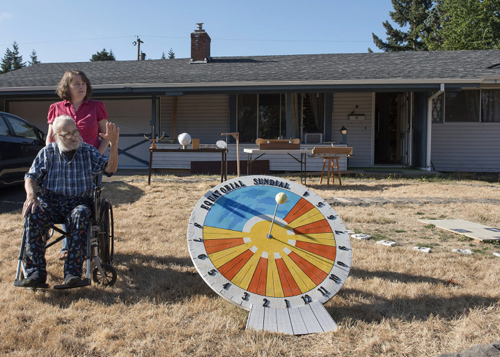 He may be wheelchair bound, but that doesn't diminish Tom Laidlaw's enthusiasim for sundials. In front of his house on Carolina Lane is the Vancouver Heights neighborhood landmark - a sundial garden. And what has he planted?
He may be wheelchair bound, but that doesn't diminish Tom Laidlaw's enthusiasim for sundials. In front of his house on Carolina Lane is the Vancouver Heights neighborhood landmark - a sundial garden. And what has he planted?
There is a bright circular equatorial sundial that shows the time from 4am to 8pm (and even an offset for daylight saving time). On the grass is an analemmatic sundial sundial marking time from 6am to 6pm for anyone who wants to stand to the plywood walkway. On a table near the house are a series of globe, equatorial and horizontal sundials as well as other sundial types that he will gladly explain. For example, Tom has turned a skate board into a polar dial by adding a "T" gnomon in the middle. And then there is a model of the Jefferson dial where you swing the gnomon around a globe to cast only a thin line shadow
Katie Gillespie, of the Columbian, reports "The 80-year-old retired electrician has always been a 'do-it-yourself kind of guy,' he said. For a while, it was skateboards he fancied, and bookshelves, and a Benjamin Franklin chair that transforms from a chair into a stepladder. He’s self-taught, he said, researching new projects online, then diving in.... 'It’s fun to watch him talk to people about it,' said Debra Brouhard, Laidlaw’s daughter and neighbor."
His latest obsession is sundials. As a member of the North American Sundial Society, Tom now designs a multitude of sundials. Visitors see his yard dotted with all types of sundials. They come in all sizes: big and small. His analemmatic sundial on the lawn always draws attention. Nearby, a plumb bob dangles from a beam. allowing Tom to tell time solar noon. when the shadow draws a line on the lawn pointing due north.
Gillespie found that, "Laidlaw’s passion for sundials began in 2009, when his grandson, Doug Brouhard, stuck a stick in the ground while they were camping. Doug Brouhard was about 12 at the time, and the dial didn’t quite work, Laidlaw said. It was the right idea, though, and a new hobby was born. 'I still have the stick that started it all,' Doug Brouhard said."
Read more of Katie Gillespie's article and see more photos of Tom Laidlaw and his sundials at http://www.columbian.com/news/2017/aug/30/sundial-garden-shines-in-vancouver-heights/
BSS Sundialist and Webmaster Passes
- Details
- Hits: 10294
|
|
Richard Mallet, former British Sundial Society Trustee, Council Member and former BSS Webmaster passed away on Nov 7th, 2016 with funeral held on Dec 12th, 2016. He lived in Eaton Bray, UK and had many interest in physics, mathematics, and sundialing. Those of us maintaining websites know of the difficulty in perserving order, yet always allowing for expansion of new material. "After a near disaster with the [British] Sundial Society's then heavily modified and entirely non-compliant website, Richard stepped in at no charge to the Society to rewrite it using the then new Expression Web software from Microsoft. This proved very successful and was of course fully W3C compliant."
Over the next year, the North American Sundial Society website will migrate from an older version of the Joomla Content Management System to the fully maintainable Joomla 3.x version. The majority of content and organization will remain intact, but new innovations are expected.
Read more about Richard Mallet's life at: http://www.ppowers.com/mallett.htm
Seattle - Sundial Capital of North America
- Details
- Hits: 14146
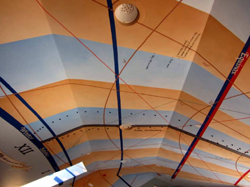 In the May 14, 2013 edition of The Seattle Times University of Washington professor Woody Sullivan was honored as ‘Mr. Sundial’ for his persistence in declaring Seattle as the Sundial Capital of North America. Dr. Sullivan has worked on more than a dozen dials in Seattle, including the large 20x30 foot vertical dial on southwest wall of the Physics and Astronomy building at UW and the elegant 11x17 foot reflection sundial painted on the ceiling of his garage at N 47° 41.232, W 122° 21.562. A small circular mirror outside the south facing window reflects a spot of light onto the ceiling.
In the May 14, 2013 edition of The Seattle Times University of Washington professor Woody Sullivan was honored as ‘Mr. Sundial’ for his persistence in declaring Seattle as the Sundial Capital of North America. Dr. Sullivan has worked on more than a dozen dials in Seattle, including the large 20x30 foot vertical dial on southwest wall of the Physics and Astronomy building at UW and the elegant 11x17 foot reflection sundial painted on the ceiling of his garage at N 47° 41.232, W 122° 21.562. A small circular mirror outside the south facing window reflects a spot of light onto the ceiling.
The reflection sundial was a labor of love taking over 3 years to create. Woody marked over 700 locations on the ceiling that allowed him to draw the local solar time, dates, hours of daylight, solar azimuth and altitude, analemma, and even hours to dawn. And being a radio astronomer, he marked the transit sidereal time for two radio sources. The dial was painted with marvelous beauty by a local mural artist, Jim Noonan. The sundial is very personal to Woody, showing time marks for the date he married to the birthdays of himself, his wife, and two daughters. The zodiac painted along the ecliptic has a local touch, representing Pisces by a pair of sockeye; Cancer by a Dungeness crab; and Capricorn as a mountain goat. There is even a compass rose.
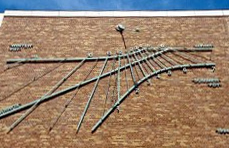 Fred Sawyer, president of the North American Sundial Society (NASS) is quoted by Erik Lacitis, Seattle Times staff reporter, saying “it’s likely true that Sullivan’s garage sundial is one of the best in North America.” When the NASS visited Seattle for the 2011 annual sundial conference, they visited Woody’s Reflection Dial and a marker was added to it for the date and time of itsofficial dial dedication held on Saturday 22 August 2011. “We toasted the sundial with an appropriate wine, ‘Wehlener Sonnenuhr’ by Joh. Hos. Prum, the fine Mosel Kabinett from the German vineyard with a large vertical sundial.” said Roger Bailey, the society’s secretary.
Fred Sawyer, president of the North American Sundial Society (NASS) is quoted by Erik Lacitis, Seattle Times staff reporter, saying “it’s likely true that Sullivan’s garage sundial is one of the best in North America.” When the NASS visited Seattle for the 2011 annual sundial conference, they visited Woody’s Reflection Dial and a marker was added to it for the date and time of itsofficial dial dedication held on Saturday 22 August 2011. “We toasted the sundial with an appropriate wine, ‘Wehlener Sonnenuhr’ by Joh. Hos. Prum, the fine Mosel Kabinett from the German vineyard with a large vertical sundial.” said Roger Bailey, the society’s secretary.
Among Dr. Sullivan’s accomplishments in the world of sundials began in the early 1990’s when the University of Washington’s Physics and Astronomy Building was being designed. He suggested a large vertical (southwest declining) sundial. The dial was completed in 1994 and Woody was hooked. He also helped design sundials used on the Mars exploration rovers Sprit and Opportunity that landed ion the Martian surface in 2004. A campaign to build sundials all around our world ensued with the motto “Two Worlds One Sun”. [photos from NASS]
Italian Gnomonist Giacomo Agnelli Dies
- Details
- Hits: 11276
Dear Friends,
A great loss has hit our gnomonic community in Italy. Our friend Giacomo Agnelli died about a week ago. Giacomo was one of the great gnomonists of the past. He had written dozens of articles in engineering and horology, also dealing with mechatronics [mechanical] sundials. He had worked at the European space project, and had frequent ...articles for our magazines [on] gnomonics. He had participated in all meetings of horology in Italy and was known for his satirical cartoons and gnomonic caricatures ...
Marjorie Kelly Webster, Collector of Sundials and Scientific Instrument Passes at 95
- Details
- Hits: 13183
Along with her husband, Mrs. Webster spent much of her life and fortune combing auction catalogs and antiquarian shops to create a collection of early scientific instruments so renowned, it is considered in the same company as the Museum of the History of Science at Oxford University and the National Maritime Museum in Greenwich, England, according to Bolt, Adler planetarium vice president for collections. The Websters are primarily responsible for the world-class collection of scientific instruments at the Adler.
NASS is supporting the Adler to catalog their sundial collection enhanced over the years by Marjorie Kelly and her husband.
Biography of Gino Schiavone
- Details
- Hits: 12583
 Gino Schiavone: After studying Liberal Arts at Loyola University and Fine Arts at Chouinard Art Institute in Los Angeles I began a career of what I called “making wonderful things.” Some thirty years ago I happened upon some books about sundials at a library. This happy accident changed my life. These books introduced me to the wide range of sundials and methods for their design. I was enthralled and inspired; I was in love. I decided to make fine sundials and embarked on a new course of study.
Gino Schiavone: After studying Liberal Arts at Loyola University and Fine Arts at Chouinard Art Institute in Los Angeles I began a career of what I called “making wonderful things.” Some thirty years ago I happened upon some books about sundials at a library. This happy accident changed my life. These books introduced me to the wide range of sundials and methods for their design. I was enthralled and inspired; I was in love. I decided to make fine sundials and embarked on a new course of study.

 Richard Mallet at Cornell Univ. Sundial
Richard Mallet at Cornell Univ. Sundial